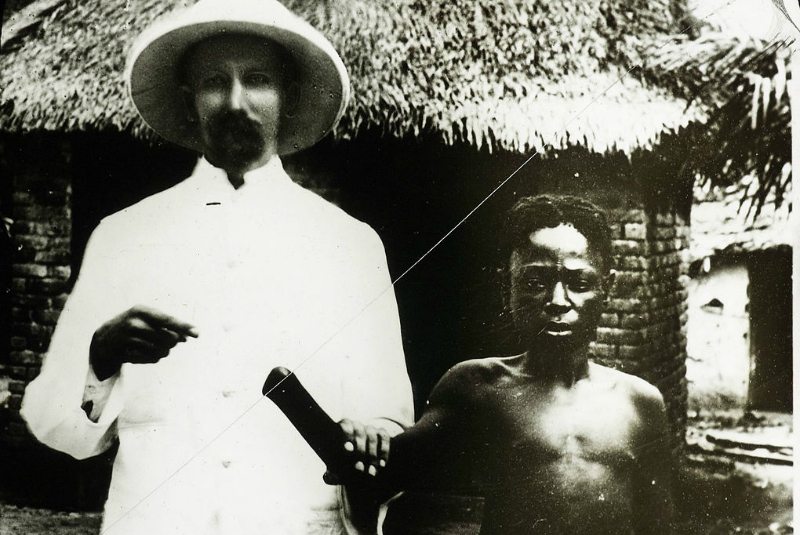Leopold II of Belgium
Episode #1 of the course Deadliest dictators in history
King Leopold II of Belgium (1835–1909) ruled for over 40 years. For 20 years, he “owned” the Free State of Congo in central Africa, a 3,000-square-mile section of resource-rich interior jungle and savannah. Leopold’s private police force, the Force Publique, terrorized and exploited Congo, largely in secrecy. Congolese people were blackmailed into working; they were often raped, tortured, and maimed. It is estimated that 10 million people—about half of the country’s population at the time—died during Leopold’s reign.
Belgium was a relatively young country during Leopold’s ascension to power. Leopold sought out colonies, first attempting to purchase, then to steal, the Philippines from Spain, but his efforts failed.

Prince Rupprecht of Bavaria and King Leopold II of Belgium, who was in the process of turning the Belgian Congo into a horrible slave colony that would make him unimaginably rich.
Credit: Bundesarchiv, Bild 102-00915. Foto: o.Ang. 1 Dezember 1924.
Instead, he took out private loans from the Belgian government to finance the “purchase” of land in Africa from indigenous rulers. The conditions presented to African rulers during these “sales” stated that for “one piece of cloth per month” in addition to “cloth in hand,” the Africans would relinquish claims and rights to land and its resources forever.
Leopold dispatched private police with orders to use whatever tactics necessary to subdue people into working. At first, Leopold ordered the ivory supply to be exploited and exported. But when demand for rubber exploded, he ordered it be harvested using any method necessary.
European agents were assigned a daily rubber quota, and if the order was not met, the agent lost pay and benefits. In order to maintain quotas, agents used brute terrorism to force people to work. Congolese people were captured and forced into labor under torturous conditions. A man’s family or relatives might be kidnapped, beaten, and held hostage while he was sent to the rubber forests. If the man did not return with enough rubber, his kin was often raped, tortured, or maimed. Belgian agents were ordered to avoid “wasting” bullets on executions, so instead they chopped off Congolese people’s hands and preserved them as trophies of their “thriftiness” and “protection of resources.” Disembodied hands were also used to intimidate and threaten the Congolese people. Even the hands of children.

A child victim of Belgian atrocities in Congo stands with a missionary (probably Mr Wallbaum), Congo, ca. 1890-1910
In addition to the murder, disease epidemics destroyed Congo’s populations. For over a decade, the mutilations and murders were largely covered up. Very few missionaries were allowed in Congo and on only the strictest of conditions.
According to the World History Archives, in 1890, a clerk at a British shipping line, Edmund Dene Morel, noticed that rubber and ivory came out of Congo, but nothing went in except soldiers and guns. He began a campaign in Britain to expose Leopold’s atrocities. Joseph Conrad’s novel Heart of Darkness furthered social interest in Africa. Eventually, British officials ordered Irish human rights activist Sir Roger Casement to provide a report. Casement’s scathing 1906 report was so severe that London’s Foreign Office would not publish the original.
In 1906, the Belgian government began negotiations with Leopold to “buy” the land from him. It took two years to finalize the sale, after which the land was redesignated as the Belgian Congo and became a colonial state. Leopold died the following year, 1909, without any formal prosecution for his actions.
In 1960, Congo gained its independence and became the Republic of Congo. Che Guevara, the communist guerilla leader, went to Congo in the 1960s to assist with establishing a new government. According to his diary, Congo was struggling and suffering greatly in “waging a relentless struggle against imperialism” in the psychology and “heroic character” of the Congolese people.
One BBC reporter in modern Congo claims that the country still struggles to recover from Leopold’s legacy, over a century later. The Democratic Republic of Congo remains the most impoverished nation in the world.
Recommended book
“King Leopold’s Ghost: A Story of Greed, Terror, and Heroism in Colonial Africa” by Adam Hochschild
Share with friends

